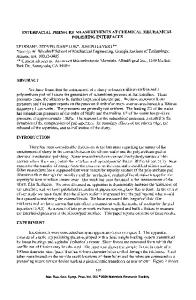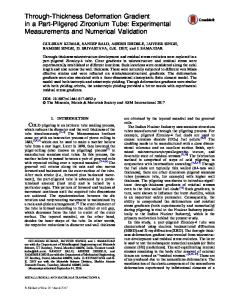Measurements of diffusion thickness at polymer interfaces by nanoindentation: A numerically calibrated experimental appr
- PDF / 895,854 Bytes
- 8 Pages / 584.957 x 782.986 pts Page_size
- 17 Downloads / 345 Views
Chieh-Tsung Lo Chemical and Biological Engineering, Iowa State University, Ames, Iowa 50011-2271
Ashraf F. Bastawrosa) Aerospace Engineering and Mechanics, Iowa State University, Ames, Iowa 50011-2271
Balaji Narasimhan Chemical and Biological Engineering, Iowa State University, Ames, Iowa 50011-2271 (Received 18 July 2008; accepted 31 October 2008)
The interfacial fracture toughness and the adhesion strength of two dissimilar materials are governed by the diffusion interfacial thickness and its mechanical characteristics. A new testing methodology is implemented here to estimate the actual interfacial thickness from a series of nanoindentations across the interface, under the same applied load, with tip radius and indentation depth many times larger than the interface thickness. The bimaterial system used is a semicrystalline polymer interface of isotactic polypropylene and linear low-density polyethylene. The laminate is prepared under a range of diffusion temperature to yield diffusion interfaces of 0 to 50 nm. A numerical relationship is developed using two-dimensional (2D) finite element simulation to correlate the true interfacial thickness, measured by transmission electron microscopy, with the experimentally estimated apparent interfacial thickness, derived from the transition domain of a series of indents across the interface. A range of material-pairs property combinations are examined for Young’s modulus ratio E1/E2 = 1 to 3, yield strength ratio sY1/sY2 = 1 to 2.5, and interfacial thickness of 0 to 100 nm. The proposed methodology and the numerically calibrated relationship are in good agreement with the true interfacial thickness. I. INTRODUCTION
Many engineering applications use a variety of dissimilar materials in the form of multilayers, interpenetrating networks of particles, and fiber composites, which are widely used in thermal, mechanical, electrical, and biological applications. Accordingly, interfaces and interfacial properties have been the focus of academic and industrial researches for several decades. The interfacial thickness is one of the important parameters that control the mechanical properties at the interface. The adhesion strength and fracture toughness of the interface between dissimilar materials are primarily controlled by the interfacial thickness for a given set of material parameters,1 wherein the interfacial adhesion strength approaches that of the bulk material.2 In many situations, the interfacial thickness ranges from almost 0 for two completely immiscible materials, to a finite thickness that may reach tens of nanometers when limited a)
Address all correspondence to this author. e-mail: [email protected] DOI: 10.1557/JMR.2009.0106 J. Mater. Res., Vol. 24, No. 3, Mar 2009
http://journals.cambridge.org
Downloaded: 25 Mar 2015
diffusion is permitted in the interfacial region. A common method to estimate interfacial thickness is through imaging via scanning transmission or transmission electron microscopy (STEM or TEM).3 In this paper, a new experimental approach is
Data Loading...











